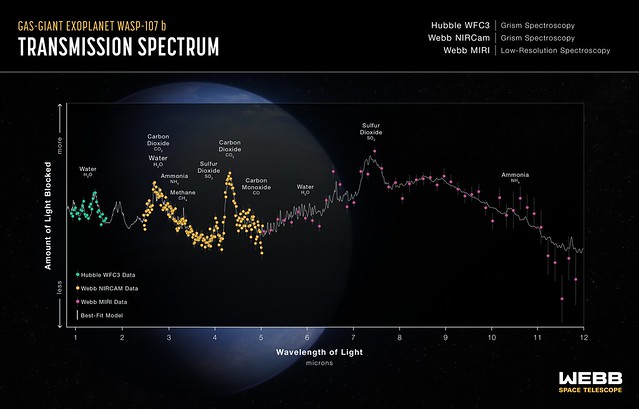James Webb Space Telescope Feed Post
Warm Gas-Giant Exoplanet WASP-107 b Transmission Spectrum (Hubble WFC3, Webb NIRCam, Webb MIRI)
This transmission spectrum, captured using NASA’s Hubble and James Webb space telescopes, shows the amounts of different wavelengths (colors) of starlight blocked by the atmosphere of the gas-giant exoplanet WASP-107 b. The spectrum includes light collected over five separate observations using a total of three different instruments: Hubble’s WFC3 (0.8–1.6 microns), Webb’s NIRCam (2.4–4.0 microns and 3.9–5.0 microns), and Webb’s MIRI (5–12 microns). Each set of measurements was made by observing the planet-star system for about 10 hours before, during, and after the transit as the planet moved across the face of the star. By comparing the brightness of light filtered through the planet’s atmosphere (transmitted light) to unfiltered starlight, it is possible to calculate the amount of each wavelength that is blocked by the atmosphere. Since each molecule absorbs a unique combination of wavelengths, the transmission spectrum can be used to constrain the abundance of various gases. This spectrum shows clear evidence for water (H2O), carbon dioxide (CO2), carbon monoxide (CO), methane (CH4), sulfur dioxide (SO2), and ammonia (NH3) in the planet’s atmosphere, allowing researchers to estimate the interior temperature and mass of the core. This wavelength coverage from optical to mid-infrared is the broadest of any exoplanet transmission spectrum to date, and includes the first reported space telescope detection of ammonia in an exoplanet atmosphere. Credits: Illustration: NASA, ESA, CSA, Ralf Crawford (STScI) Science: Luis Welbanks (ASU), JWST MANATEE Team Image description: Graphic titled “Hot Gas-Giant Exoplanet WASP-107 b Transmission Spectrum: Hubble WFC3 Grism Spectroscopy; Webb NIRCam Grism Spectroscopy; Webb MIRI Low-Resolution Spectroscopy” has 3 sets of data points with error bars and a best-fit model on a graph of Amount of Light Blocked on the y-axis versus Wavelength of Light in microns on the x-axis. Y-axis ranges from less light blocked at bottom to more light blocked at top. X-axis ranges from 0.8 to 12 microns. Data are identified in a legend. Hubble WFC3: 30 green data points ranging from 0.9 to 1.6 microns; Webb NIRCam: 177 orange data points ranging from 2.5 to 5 microns; Webb MIRI: 46 pink data points ranging from 5 to 12 microns. Best-fit model is a gray line with numerous peaks and valleys. The model and data are closely aligned. Ten features on the graph are labeled: Water H2O; Water H2O and Carbon Dioxide CO2; Ammonia NH3; Methane CH4; Sulfur Dioxide SO2; Carbon Dioxide CO2; Carbon Monoxide CO; Water H2O; Sulfur Dioxide SO2; and Ammonia NH3. Image & Description by NASA
